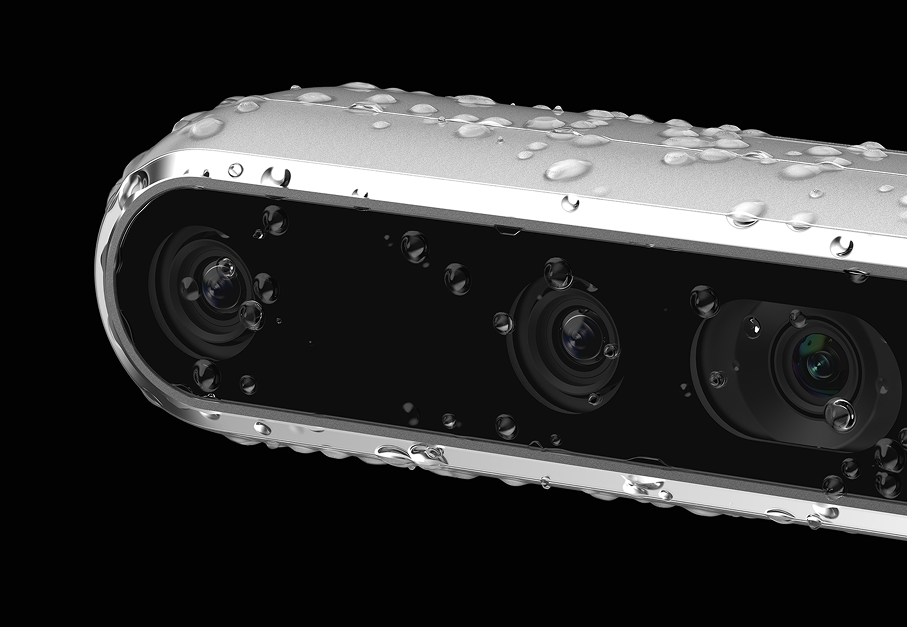Protocol® with RealSense™ F455 facial authentication automates identity-based access control, blocking high-risk entry and strengthening biosecurity.
The challenge
Diseases like PRRS and avian flu cost North American producers billions annually, with human movement between farms being a major source of transmission. Traditional biosecurity tools, like clipboards and sign-in sheets, are outdated and prone to error.
The solution
FHG’s Protocol system uses RealSense™ F455 facial authentication to automate access control at farm entry points, ensuring only cleared individuals enter based on recent farm visits and real-time risk.
The results
With RealSense™ technology at the core, producers gain full visibility into site access, veterinarians can enforce protocols automatically, and compliance improves even with high staff turnover—ultimately protecting animal health and strengthening biosecurity.
The Protocol® system from Farm Health Guardian® (FHG) is transforming farm biosecurity using RealSense F455 ID facial authentication. By automating access control based on identity and movement history, Protocol prevents high-risk individuals from unknowingly spreading diseases like PRRS and avian flu. The F455’s rugged design, fast biometric processing and precise recognition capabilities make it the ideal solution for the demanding conditions of modern farming.
Challenge: Automating Biosecurity in a High-Stakes Industry
In the global pork industry, disease is the second-largest cost driver, resulting in billions in losses annually and posing major threats to animal welfare, supply chains and food security.
Porcine reproductive and respiratory syndrome (PRRS) consistently plagues the U.S. pork farmer, costing the industry more than $1.2 billion in lost production each year. Concern about PRRS is top of mind for producers, especially as the disease is no longer confined to one season but can now affect herds year-round.
In Canada, PRRS costs producers over $200 million annually. In 2022, highly pathogenic avian influenza (HPAI) led to the loss of nearly seven million birds on Canadian poultry farms.
One major vector is clear: human movement between farms. Yet traditional biosecurity enforcement has relied on paper sign-in sheets, verbal instructions, phone calls and best-effort compliance — approaches that are inadequate, inconsistent and prone to error.
Which is why biosecurity took center stage at the 2025 World Pork Expo.
“Biosecurity is traditionally clipboards, spreadsheets and hope,” said Rob Hannam, CEO of FHG. “We knew the industry needed a smarter, automated and scalable system. That’s where Protocol comes in.”
Solution: Protocol — Facial Authentication for Farm Biosecurity
Strengthened biosecurity measures help curb diseases that affect herds. Protocol, FHG’s biosecurity control system, uses F455 cameras to automate and enforce identity-based access control at critical farm entry points 24/7. It protects against PRRS, avian flu and other transmissible diseases by ensuring only approved individuals can enter barns or production areas — based not just on who they are but where they’ve been.
“Very simply, it authenticates who a person is,” said Anthony Novero, chief technology officer at FHG. “The software checks their recent farm locations and access history. If they were on a high-risk farm earlier that morning, then they’re denied entry in the afternoon.”
The system is especially impactful for operations with multiple farm sites, such as integrated pork production systems, transport or feed companies and veterinarians managing regional supply chains. But it is equally relevant for smaller operations and veterinarians who cover a smaller area. Disease can happen at any site. Customizable access rules are applied in real time, considering downtime, prior visits and the health status of each farm site.
“Veterinarians are a key user of our software, because they’re trying to protect the health of the animals in each of those barns and they travel frequently to different sites,” Hannam added. “Previously, they lacked visibility into human movement between farms or the potential risk of people entering the wrong farm.”
Protocol automates enforcement of each veterinarian’s biosecurity plans with current, accurate data based on the health status at that time, replacing spreadsheets that are emailed and hard to read.
The system also eases the challenges of high staff turnover. With new employees constantly rotating through barns, training and compliance can be inconsistent. Protocol simplifies onboarding and standardizes biosecurity adherence across teams.
RealSense ID: Built for the Barnyard
FHG evaluated multiple biometric systems — including fingerprint and palm scanners — but routine farm conditions made them unreliable. Gloves, mud, extreme temperatures and moisture created too many failures.
Facial authentication with the F455 proved to be the ideal solution. “Farmers and producers can be in hot areas, such as the southern U.S. or Mexico, but they could also be in central or northern Canada, where you’re going to get snow and ice buildup,” noted Hannam. “Unlike fingerprints, the RealSense ID camera is durable across all climates.”
“RealSense ID was the genesis of our facial recognition system,” added Novero. “I remember logging into an old Surface Book with Windows Hello software and a RealSense ID camera and thinking, ‘Why aren’t we using this to log into barns?’ That was the spark.”
A major benefit of the F455 is its built-in biometric processor, enabling fast, real-time on-device authentication. The camera’s processor reduces system load while its sensors function reliably even in remote or harsh environments. Its large vertical field of view accommodates varied user heights, while IR illumination enables performance indoors and outdoors.
“Once we saw the F455 in action, it was an easy decision to have that be the focus of our entire platform,” said Hannam. “We, then, worked closely with RealSense engineers to integrate the F455 into our systems. That partnership was essential.”
Protocol’s architecture includes a secure biometric template server, allowing users enrolled at one site to be authenticated at others — critical for mobile veterinarians and multi-site operations. The system also ensures compliance with veterinary directives in high-risk scenarios.
While the biometric system detects breaches and alerts the farm, the goal is to avoid the individual coming on site. However, if they still drive to the site – assuming they haven’t received an alert or didn’t pay attention to it – when they approach the barn door and are recognized, the device tells them why they can’t open a door. Then a breach alert is sent to the appropriate farm staff: “User X, tried to open this door today at 3 o’clock in the afternoon, but they were at another barn this morning that presents a risk to this barn, so they were not allowed to enter.”
“If someone approaches a door after visiting a compromised site, the system not only denies access but sends real-time alerts,” explained Novero. “The person is notified via an alert to their phone and told why they’re being denied. That’s the person we need to stop from entering. At the same time, the veterinarian, farm manager and owner all receive an alert.”
Beyond the Barn Door: Controlling Equipment and Supply Intake
Protocol also secures other critical biosecurity checkpoints, such as fumigation and supply rooms. RealSense ID facial authentication cameras monitor roll-up doors, verify authorized personnel and ensure proper decontamination processes (e.g., fogging or temperature holds) are completed before supplies enter the farm.
“You can think of it as a decontamination airlock,” said Hannam. “Veterinarians might require supplies to sit at a certain temperature for a certain number of hours or be fogged. We’ve automated that entire process. Two Protocol devices on either door of the decontamination room track and enforce those steps. Only authorized users can open the doors — and only once the veterinarian’s criteria are met.”
This reduces human error and prevents contamination from deliveries — another key risk point in farm operations.
Results: Compliance, Visibility and Healthier Herds
The impact of Protocol controlled access is immediate and measurable:
- Veterinarian-directed policies are enforced automatically, ensuring that animal health policies are followed without relying on phone calls or human memory.
- Real-time risk alerts notify teams before potential breaches occur.
- Complete visibility into who enters and exits which sites — and when.
- Employee ease-of-use has improved compliance and reduced training burdens in a high-turnover industry.
“Our customers, which are some of the largest pork producers in North America, are rewriting their biosecurity protocols based on what Protocol uncovers,” said Novero. “Before using our system, they thought they were doing a great job at isolating their healthy barns from those that weren’t. The system shows them risks they didn’t even know existed.”
Farm staff appreciate the technology because it’s easy to use the helps protect the animals in their care. Veterinarians now have full visibility and automated enforcement of their biosecurity protocols. And producers benefit from healthier herds and more resilient businesses.
In an industry where respiratory disease in swine has increased by 80% over the past decade, this kind of insight and control is game-changing.
A Strong Partnership for the Future
Today, Protocol is being deployed across major pork operations North America with expansion into poultry and other livestock planned for the future. RealSense ID technology remains central to this growth.
“Once we saw the F455 in action, it was an easy decision to build our future on it,” said Novero. “The technology just works — and it offers exactly the kind of authentication farms need.”
With RealSense ID vision technology at its core, FHG is redefining what modern farm biosecurity looks like — bringing intelligence, automation and peace of mind to the barnyard and beyond.
The heart
of the solution
RealSense™ F455 is the RealSense product powering Protocol® by Farm Health Guardian, ensuring secure, automated, identity-based access control for modern farm biosecurity systems.
“Farmers and producers can be in hot areas, such as the southern U.S. or Mexico, but they could also be in central or northern Canada, where you’re going to get snow and ice buildup…Unlike fingerprints, the RealSense camera is durable across all climates.”
— Rob Hannam,
CEO, Farm Health Guardian (FHG)


